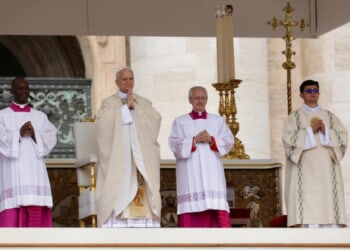For the United States, Iran, and Israel a negotiated deal is a far better outcome than preventive war or nuclear proliferation.
Several short rounds of US-Iran nuclear negotiations have sufficed to demonstrate that a great deal is not in the cards, certainly not soon. But not all is lost if we consider a creative way to bridge the gap between the negotiating goals all key parties have set for themselves.
President Trump aims for a perfect agreement in which Iran’s nuclear weapons program is fully dismantled—an achievement that eluded President Barack Obama. Such a deal would ensue now only because Trump dared to apply maximum pressure on the Ayatollahs, threatening them with a military attack while also extending them a generous diplomatic hand.
He aims for an accord that would win him a Nobel Peace Prize for averting war and burnish his credentials as the master negotiator and peacemaker. Operationally, he seeks an accord that the Europeans could not claim credit for, one that Congressional hawks would endorse and even Israeli Prime Minister Benjamin Netanyahu would not dare undermine.
The Iranians, on the other hand, harbor serious misgivings about the United States in general and President Trump in particular as a negotiating partner. Yet, they are now weak militarily, feeble economically, and bereft of their traditional proxies like Hezbollah that would have dissuaded and retaliated against US-Israeli military action.
Accordingly, Iran’s leadership has grudgingly agreed to “indirect negotiations” in order to end the stifling sanctions. Above all, they fear an economic meltdown, an uprising, a war, or normalization with the West that could spell the end of the Islamic regime. Toward these ends, they are determined to preserve Iran’s nuclear option and power projection capabilities like ballistic missiles and regional proxies.
Finally, Netanyahu, reflecting a genuine Israeli concern about Iran’s intentions and capabilities, cannot conceive of a diplomatic outcome with Iran that he would like anything other than a Libya-style complete surrender of the nuclear program. Coupled with a full stop to Iran’s subversive activity throughout the Middle East. He would much rather see the negotiations fail, forcing the United States to join Israel in an operation to destroy Iran’s nuclear infrastructure and, ideally, topple its repressive Islamic regime as well.
Reconciling these conflicting goals, let alone doing so quickly, is nearly impossible. Yet, with skillful diplomacy, one can envisage parameters of a deal that, while falling far short of meeting the goals the various key parties aspire to, is nevertheless both desirable and potentially acceptable to all. An imperfect deal that President Trump could present as a major accomplishment is clearly preferable to the two leading alternatives: preventive war or Iranian possession of nuclear weapons. What could such an agreement look like?
As part of such a deal, Iran would be expected to fulfill its obligations under the Nuclear Non-Proliferation Treaty and undertake to comprehensively, indefinitely, and verifiably refrain from coming within striking distance of nuclear weapons across all four domains that count: fissile materials, weaponization, delivery, and militarizing its nuclear assets.
The International Atomic Energy Agency (IAEA) would be allowed to monitor and inspect all Iranian fissile material. It would be authorized to employ its entire verification toolkit, including rarely used instruments like the Additional Protocol, Broader Conclusion, and Special Inspection. However, the ultimate determinant of Iranian compliance should be the United States’ intelligence prowess, which even the Iranians know they cannot evade.
In return, the United States could accept a modest, low-level residual enrichment stockpile and activity as long as it is directly pegged to demonstrable commercial requirements or transferred to a regional fuel cycle arrangement. Furthermore, it could reassure Iran that it would undertake no coercive actions against its nuclear program as long as Tehran fully adheres to its commitments under the deal.
Washington could also offer Iran broad sanctions relief, provided that both the IAEA and US intelligence can confirm its compliance with its obligations. The United States could also apply additional sanctions relief if Iran agrees to curtail its support for terrorist activity and halt weapons transfer to other parties in the region.
Finally, Israel could be grudgingly persuaded to accept such a deal in return for US security assurances. This could be achieved through a reinvigorated high-level bilateral consultative mechanism that compares notes on Iranian conduct and coordinates responses to the challenges it presents, in addition to a US commitment to sustain and extend long-term military assistance to Israel, which enhances its retaliatory options in case Iran reneges on its commitments under the deal.
The bottom line is clear. A diplomatic outcome acceptable to all key stakeholders is within reach. Provided negotiators do not get bogged down, as in the past, by years-long negotiations, endless technical details, and time-bound commitments. The most promising way forward is a deal that is anchored in a handful of fundamental principles, open-ended commitments, and well-honed, comprehensive, and robust verification schemes, both unilateral and multilateral. Above all, a credible deterrence scheme against cheating and an equally serious incentive structure for compliance by all parties should prevail.
About the Author: Ariel Levite
Ariel (Eli) Levite is a senior fellow at the Carnegie Endowment for International Peace and Harvard’s Belfer Center for Science and International Affairs. He served as Principal Deputy Director General (Policy) of the Israeli Atomic Energy Commission.
Image: Noamgalai / Shutterstock.com.














